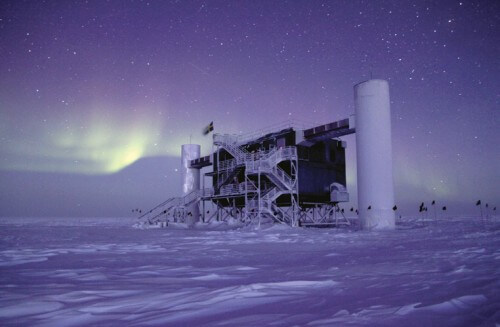Neutrinos from deep space herald a new kind of astronomy

The glow of the night stars carries with it news from the far reaches of the cosmos. When the starlight reaches the telescopes it tells the astronomers about the strange and wonderful processes of the universe. But the light is not able to tell the whole story. It often reveals only the outer glow of objects in space. To better understand what happens in the cores of powerful astrophysical objects, scientists study other particles that are able to tell first-hand about the extreme events that launched them into space at enormous speeds. Now a promising new research front is opening, which may stimulate these investigations.
For more than a century, scientists have been capturing particles known as "cosmic rays" to gather clues about what's going on in the universe. Cosmic rays consist of charged particles (mainly protons) emitted in cosmic explosions. Some of them have energy similar to a tennis ball served at a speed of 145 km/h. Unfortunately, the origin of these particles in the sky cannot be traced. Magnetic fields whirl such charged particles on their way to Earth, twisting their paths into loops.
The light and electrically neutral neutrino particles are not affected by this. They are known for their elusiveness: a neutrino can emerge just as it was created from the center of a violent explosion, cross the universe in a straight line and pass through the Earth's atmosphere unscathed. Thanks to these properties, neutrino particles are excellent messengers of astronomical information. The difficulty is to capture them when they arrive.
Scientists have therefore built a giant neutrino detector, named IceCube, at a depth of more than a mile and a half below the surface of the Antarctic ice, hoping to capture in its net these astronomical neutrino particles. In early 2013, the Ice-Cube project announced the discovery of 28 neutrino particles whose high energy undoubtedly indicates that they came from outside the solar system. Two of these particles, which were highlighted in an article published in July 2013 in the journal Physical Review Letters, have such high energy, several hundreds of times the energy of the particles in the Large Hadron Collider (LHC), that the astronomers gave them affectionate names: Eric and Benz (in English, Ernie and Bert, the original names of the two characters in the TV series "Sesame Street").
But in the meantime there are many hypotheses dealing with the origin of these neutrino particles. They emerged, perhaps, from bursts of gamma rays, extreme, short and mysterious events that occasionally shine as the brightest objects in the universe, perhaps from shock waves that emit exploding stars or perhaps from "blazars", the jets of energy that launch supermassive black holes. And maybe Eric and Benz are products of dark matter, the unidentified substance that provides most of the mass of the universe, and maybe they are even a hint of even more exotic phenomena.
To be honest, scientists can't infer much from just 28 particles. So far, the high-energy neutrinos don't seem to point to a specific origin in the universe, which could help scientists. "Everybody reads over coffee," says Francis Helzen, director of the Ice-Cube Center for Particle Astrophysics at the University of Wisconsin-Madison. But since IceCube is expected to operate for at least ten years, the era of particle astronomy is only in its infancy.
The article was published with the permission of Scientific American Israel
More of the topic in Hayadan:
